In Nepal, child slavery wasn’t on the national radar until Olga Murray came upon the scene. This is Olga arriving at the Kathmandu, Nepal airport, surrounded by the children she has helped. Photo credit: Nepal Youth Foundation.
When Olga and I met she told me “some women fall in love with men–I fall in love with countries.” She visited Nepal in 1984 to go trekking in the Himalayas where she discovered a country and a cause to which she has devoted the rest of her life.
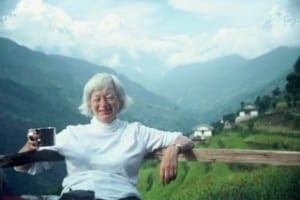
“I was almost 60, and perhaps subconsciously, I was searching for something worthwhile to do following my retirement. I got off the plane in Kathmandu and was overwhelmed by the beauty of the land, the exotic surroundings, but most of all by the children. They were poor beyond anything I had ever experienced – dressed in rags and dirt, malnourished, mostly unschooled, but with an amazing capacity for joy. I thought that for the price of a good haircut, I could make a huge difference in their lives.’*
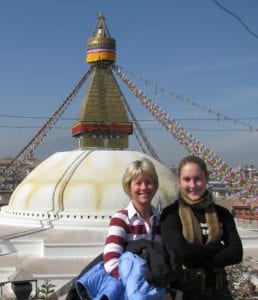
So she returned to the USA determined, somehow, to do just that.
By raiding her own savings, and securing donations from friends, she returned to Kathmandu with the wherewithal to establish a home for the country’s throwaway children – street urchins, handicapped kids, orphans, or children who had been abandoned – often by parents too poor to feed them.
As word spread about her work, generous people worldwide wanted to help. In 1990, two years before she retired, Olga founded a non-profit organization, Nepal Youth Foundation (www.nepalyouthfoundation.org) NYF, and just in time.
Over the period of 23 years I have visited Olga in Nepal numerous times and witnessed first-hand how NYF is alleviating the suffering of orphans, children infected with HIV/AIDS, children sold into slavery, the homeless, the hungry and disaster victims.
When Olga saw children dying from malnutrition, she decided to teach mothers how to feed their babies with nutritious, easily available, local foods. In Nepal 2 out of 5 children suffer from chronic malnutrition. For the majority of Nepali people in rural areas, white rice is the main source of food. Lacking adequate nutrients in their diets, mothers are often unable to produce sufficient breast milk which contributes to high rates of malnutrition and infant mortality. Olga launched the first of 17 Nutritional Homes in Kathmandu. Since 1998, more than 15,000 children have been restored to health and vitality in these homes. The model was so successful that the Nepali government has taken over running all the nutritional centers, as NYF originally planned.
A Piglet for a Girl’s Freedom
Olga and Som, who was then a social worker for NYF and is not NYF’s President, heard that fathers in a region of Southern Nepal were selling their daughters into bondage for $75 a year or less. Olga and Som came up with an idea to liberate thousands of girls living in servitude. Give a piglet to the mother to replace the income from the sale of her daughter. A piglet, given to a mother, could persuade a family to not sell their daughter. They would keep her at home, and she would attend school. NYF would provide education or vocational training, books and a school uniform. The mother could raise a pig on kitchen scraps and sell the pig or piglets and earn in a year, what the family would have earned if they sold their daughter into bondage. Why a piglet and not cash, I asked Olga? She explained that the women wanted the piglet because the man of the house might gamble or drink away the cash quickly. The micro-business of the mom could keep her daughter at home and empower both of them.
The result was that 13,000 girls, some of whom had been enslaved since the age of six, were rescued and returned to their home communities.
This program, “Free Kamlari Girls” is now self-sustaining. The girls (bought out of bondage by NYF) are now running their own NGO and are powerful advocates for their own community. It has come full circle. Som, with his master’s degree in hand, brought an action in the Supreme Court of Nepal seeking an order to force the government to comply with the United Nation’s laws on the Rights of the Child. The court’s decision outlawed the “Kamlari” practice of child servitude in Nepal.
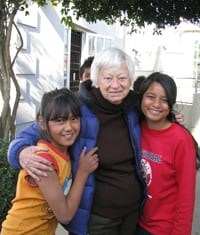
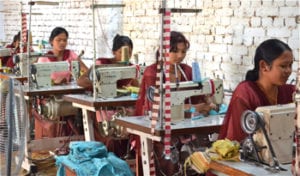
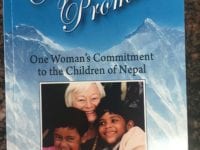
Over the past 30 years, not only has the number of supported children expanded, but so have the ways in which they are helped.In addition to scholarships, NYF funded the salaries of more than 65 teachers in various poor rural areas, and teacher training. Her foundation also runs two boarding school and nutritional programs in Kathmandu.
NYF also established four homes for children, two for boys and two for girls. They not only provide children with warm beds, hot meals, a safe haven and security, an education, and medical expenses, but love and personal attention—just as a good parent would do. And the kids will be taken care of from childhood through college.
Since her retirement in 1992, Olga has divided her time between her home in Sausalito, California, and a new home in Kathmandu, devoting all her energy to help her children. Olga was an attorney for 37 years helping to write opinions for two California Supreme Court chief justices in San Francisco.
Olga has delivered a TED TALK in Vienna, been a guest on “The Oprah Winfrey Show,” NPR, and National Geographic Weekend, and was honored by the Dalai Lama and the former King of Nepal.

She is living proof that getting older does not mean slowing down. “I’m not that different than I was 25 years ago,” Olga says. “I’ve stayed active and interested in life. Regular exercise – walking, going to the gym, lifting weights for my knees and back – has helped me stay healthy. I haven’t had a cold in fifteen years. Also, I’m more positive and more confident. I know where I’m going and what I want to do, so I don’t get so involved in my own problems.”
When there is a crisis, NYF is nimble and creative. They responded to the homeless and abandoned HIV/AIDS children with The New Life Center, a transitional haven for HIV-positive children and their caretakers, most of whom are infected mothers. After the 2015 earthquake, they shifted gears and rushed to the devastated villages and erected temporary shelters.
Most recently, NYF jumped into action to combat the COVID-19 pandemic crises of hunger and remote education.
Long before the pandemic swept into Nepal, many knew the gnawing fear of hunger. Families struggled to feed their children. Now hunger is again on the rise. Two years ago, NYF initiated a very effective, low cost program to help avoid severe malnutrition. They distribute packages of “Lito for Life”, a mixture of local and inexpensive ingredients, to communities in dire need. Each packet costs about $2 and feeds a family of four for two days.
The COVID-19 pandemic is cheating Nepali children out of an education. Since most Nepalese villages do not have computers, NYF developed a simple and affordable response. For $1,000 NYF offers a computer to a government teacher with the government curriculum downloaded on it. The teacher can remotely educate 100 children for a year by beaming classes to a big screen, provided by NYF, erected somewhere in the village. Villagers install the large screen in a schoolhouse, a community center or a vacant barn. NYF also offers school supplies for each student. It’s a brilliant idea. The teacher is free, the classroom is free and the curriculum is free. With NYF’s help, students can receive an education for $10 for the school year. This is another example of how NYF responds quickly with village-based, affordable solutions to new problems
Personal note from Marybeth explaining how I became so attached to the Nepalese people.
Why do I care about Nepal and NYF?
I was in Nepal for the first time – alone. A young woman, and alone. Across the valleys and summits of the Himalayas I lugged a backpack and slept in local homes in small villages. My goal was to trek to the Everest Base Camp to celebrate my 30th birthday. A goal I didn’t achieve because of a debilitating case of amoebic dysentery. A teenage Sherpa porter found me, curled up on a mat in a guest house, alone and very sick. He served me meals and searched through the valley for a doctor who could help me. After I received medical help I slowly recovered. Pemba didn’t forget me. He hiked for hours to return to the village where I was recuperating to repeatedly check on me. When I was strong enough to walk again, he carried my heavy backpack, in addition to those of his wealthy clients along the trail. What did he want? What would he accept from me? He insisted “Nothing” and he meant it. In the end, he did accept a picture of the two of us, that’s all. I borrowed a Polaroid camera from a fellow trekker and made one photo for him. He had a photo of a new friend and I made a new commitment.
Pemba told me that he was sold by his father to pay for a debt. He worked in the fields and lived in a barn as an indentured slave for seven years. Pemba left me and hiked down the valley with his trekking clients and I continued up another valley to the Everest Base Camp. I was 29 years old and I made a pledge to myself, “I will never forget the generosity of the people of Nepal”. Thus, began my lifelong long love affair with the people of Nepal, my eventual friendship with Olga and my witnessing the outstanding work of NYF.
*Excerpt from Olga’s Promise, by Olga Murray and Mary Sutro Callender